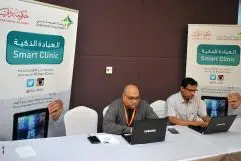PHOTO
Dubai - The Dubai Health Authority, held today a smart_clinic via its Twitter page (DHA_Dubai) to raise awareness about the importance of anaesthesia and discuss new trends in the field.
The smart clinic was held during the 8th Dubai Anaesthesia Conference which is taking place at the Mohammed Bin Rashid Academic Centre at Dubai Healthcare City.
Dr Suraj Jose, senior specialist anaesthesiologist and Dr Hany Greiss, consultant anaesthesiologist at Rashid Hospital took part in the clinic.
Information was disseminated to more than 64,000 people who follower the Dubai Health Authority's page on Twitter.
Jose highlighted that anaesthesia is needed for practically all medical procedures. "Anaesthesia is not only administered for surgical cases but also for diagnostic procedures such as MRI, CT scan and therapeutic procedures such as cardiac catherization procedures etc. where patients need to be absolutely immobile or to make the patient comfortable. E.g. Some patients feel claustrophobic while getting an MRI done, if nothing else works, anaesthesia is administered which helps sedate the patient. This is particularly useful in paediatric cases."
Jose said that on an average, 10,000 anaesthesia procedures are conducted every year at Rashid Hospital. Of these 6500 are general anaesthesia cases and 3500 are regional anaesthesia cases.
Greiss said: " In general anaesthesia, the patient will be unconscious and in regional anaesthesia the patient will be conscious and we can numb a particular part of the body. The recovery time is quicker and hospital stay is shorter when regional anaesthesia is administered
Regional anaesthesia is highly advanced to the extent that we can block a single nerve and proceed with surgery for that particular region of the body. Earlier nerve stimuli was used to block the nerves but now with the help of newer tools like ultrasound, anaesthesiologists can see the nerve directly while administrating anaesthesia. For example, for any surgery on the thumb, blockage of the radial nerve is sufficient. The patient can be awake or he can decide to opt to take a sedative so that he is asleep during the procedure."
Jose said that, in general, patients can decide which anaesthesia they prefer and the doctor advises patients about the pros and cons keeping in mind the patient's condition. Factors that will determine the type of anaesthesia includes age, comorbidities, type of surgery, duration of surgery etc. "For emergency surgeries, all patients are taken for surgery in spite of their co-morbidities and anaesthesia is administered immediately so that the surgeons can begin the surgery," said Jose. " Anaesthesia is highly advanced today and patients should discuss their options with the anaesthesiologist so that they can be as comfortable as possible before undergoing any procedure."
-Ends-
About the Dubai Health Authority
The Dubai Health Authority (DHA) was created, in June 2007, by Law 13 issued by His Highness Sheikh Mohammed bin Rashid Al Maktoum, Vice President and Prime Minister of the UAE, Ruler of Dubai, with an expanded vision to include strategic oversight for the complete health sector in Dubai and enhance private sector engagement. His Highness Sheikh Hamdan Bin Rashid Al Maktoum, Deputy Ruler of Dubai and UAE Minister of Finance is the President of the Dubai Health Authority and His Excellency Engineer Essa Al Maidoor is the Director-General of the DHA.
The DHA's aim in Dubai is to provide an accessible, effective and integrated healthcare system, protect public health and improve the quality of life within the Emirate. This is a direct translation of the objectives of the Dubai Strategic Plan 2015 launched by His Highness Sheikh Mohammed bin Rashid Al Maktoum. Keeping the strategic plan in mind, the DHA's mission is to ensure access to health services, maintain and improve the quality of these services, improve the health status of nationals, residents and visitors and oversee a dynamic, efficient and innovative health sector.
In addition to overseeing the health sector for the Emirate of Dubai, the DHA also focuses on providing services through DHA healthcare facilities including hospitals (Latifa, Dubai, Rashid and Hatta), specialty centres (e.g. the Dubai Diabetes Center) and DHA primary health centres spread throughout the Emirate of Dubai.
The main pillars of service delivery at DHA health facilities are quality, efficiency, patients and staff. It is our aim to maintain and improve the quality and efficiency of DHA health services. An important aspect of the service delivery strategy is to focus on patients, their needs and satisfaction as well as attract, retain, nurture and support outstanding staff.
Prior to the establishment of the DHA, the Department of Health and Medical Services (DOHMS), which was established in 1973, was the functioning authority that almost exclusively focused on health service delivery.
© Press Release 2015











